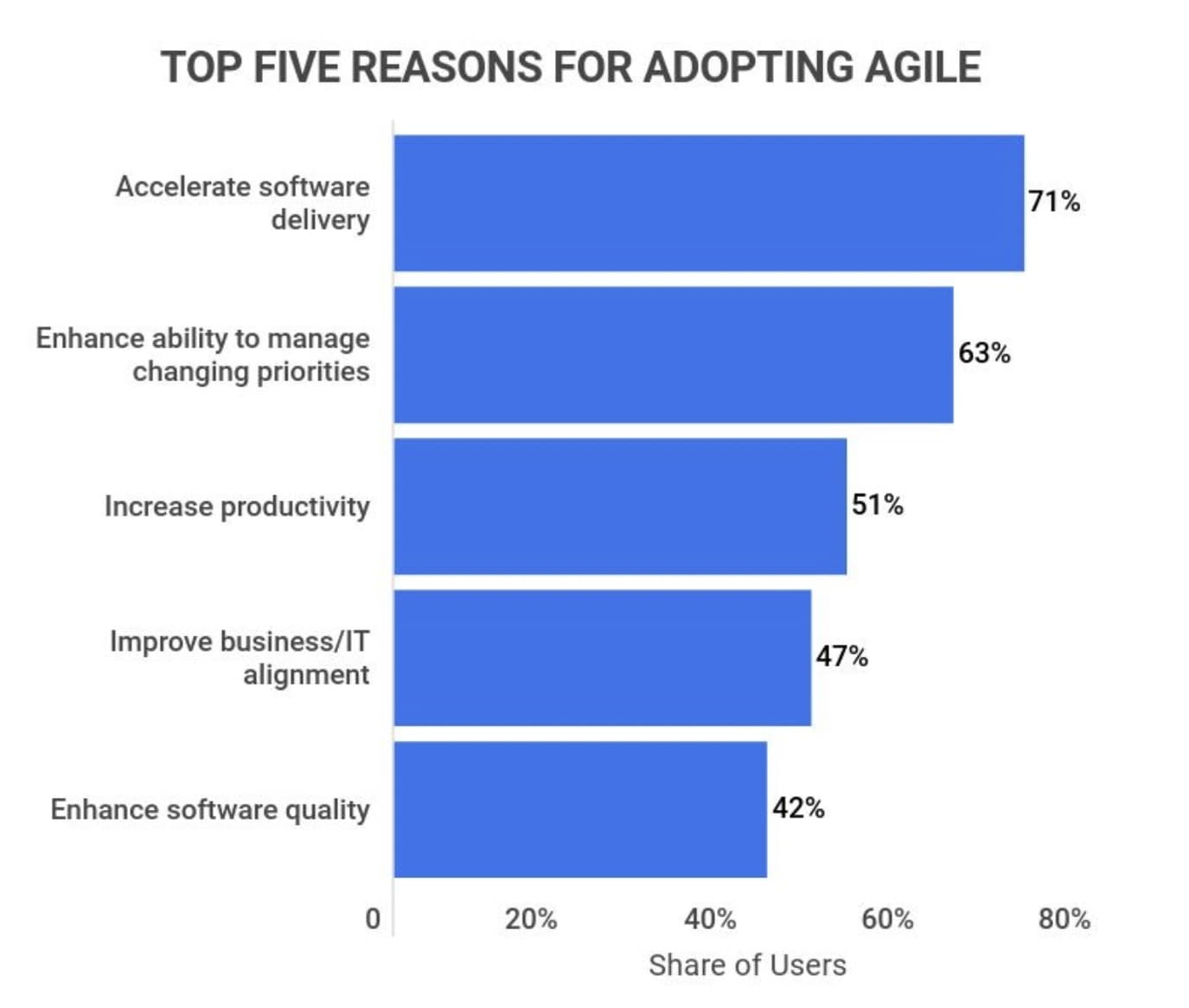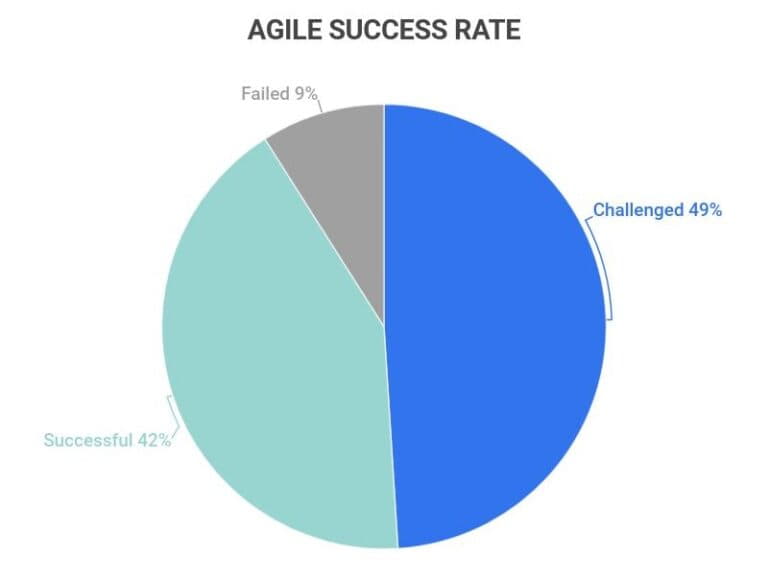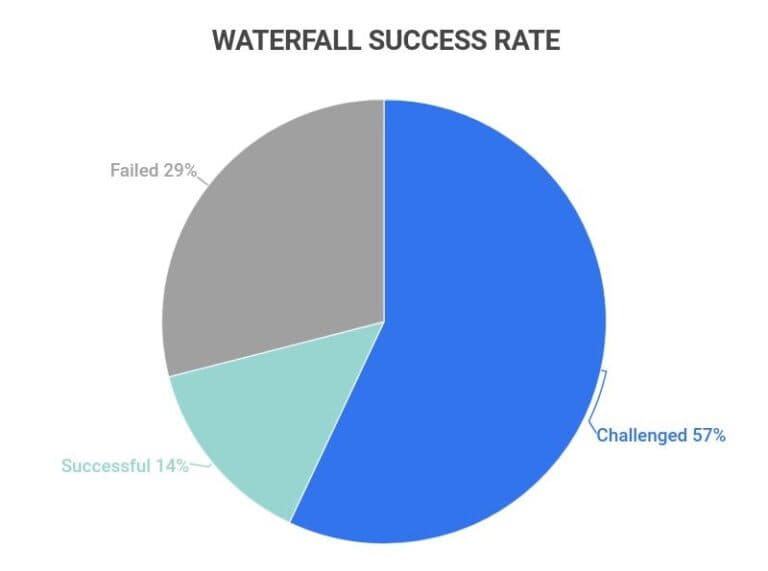The way the software industry operates has been totally transformed by Agile Methodology. Agile is not just popular in the IT sector, but also in the industrial, food & beverage, and transportation sectors. Thus, project managers frequently boast about having Agile teams working on the backlog, therefore this is common.
Projects under the competing approach known as waterfall only have a 49% success rate while projects under the agile methodology have a success rate of 64%. However, organizations weren't prepared for the transition, thus it initially met with a lot of pushback. The most common reason for opposition to agile is that people fear change. We all have a certain amount of change aversion, and switching from more conventional development methods to a fully Agile framework represents a significant change that affects almost every employee in an organization.
Effective use of the agile software development process aids teams in considerably raising the caliber of each new release of their product. Therefore, gradually it has resulted in enabling teams to quickly adjust to change due to the method’s outcome. The purpose of this article is to highlight the benefits of agile methodology and elaborate on its popularity in the industry.
Checklist
Insights of Agile Development
Companies can no longer afford to let process, protocol, and documentation hinder time to market as customer demand drives product development. Such delays deprive businesses of their ability to compete, and eventually, customers. By identifying client needs, agile software development and testing contribute to the solution of this issue. Agile software development prioritizes usable software above exhaustive documentation, as well as stakeholder involvement, customer collaboration, and process transparency.
Agile methodology is based on four principles:
- Software that prioritizes thorough documentation
- Individual discussions concerning tools and procedures
- Constant communication with clients regarding requirement changes
- Following a plan, while adapting to change as required

Source: Zippia
According to the statistics, those who have indulged and applied the methodology of agile to their working process have given positive feedback. In a word, agile is a project management methodology that encourages iterative and incremental development to assist teams to meet the demands of the modern workplace. It includes various techniques, all of which are focusing on adaptability, openness, maintaining high quality, and constant progress toward improvement.
When it comes to software development before agile arrived in the picture, the popular waterfall methodology was the holy grail. The Agile technique operates on the premise of moving quickly and incrementally, in contrast to the waterfall process of planning, designing, building, testing, and delivering the products. Therefore, it is the reason that sets agile apart and makes it more popular. Let us see some of the success rates of projects using both methodologies.


Source: Zippia
The failure rate for Agile and Waterfall is 9% and 29%, respectively. Thus, the difference clearly states the effectiveness and agility of agile methodology to deliver projects with impeccable results.
However, nothing is perfect, every methodology draws attention to some disadvantages. The drawbacks of agile can be classified into 5 parts, such as, poor resource planning, limited documentation, fragmented output, not knowing the final look of the product, and finally measuring the timeline. The agile methodology calls for a lean strategy to ensure that you do not run into these obstacles while working on the project– Instead of just delivering a functional product, you must make sure that you add value by producing a high-quality final product. Second, maintaining a precise delivery procedure rather than an ambiguous path chosen along the way.
Therefore, it is abundantly obvious from the statistics that agile methodology is becoming increasingly popular. Now, Let’s look at some of the benefits you can gain from it and the core reasons for it to become popular:
6 Reasons Behind Agile's Growing Popularity in Software Development
Agile is Faster and Reduces Technical Debt:
Agile focuses on releasing the initial iteration within a few weeks or the full software product within a few months. While other approaches emphasize the pre-designed steps of planning, designing, developing, testing, and producing the final product. This process can take several months or even years.
Additionally, agile minimizes technological debt. The tasks needed to support the current product are referred to as having technical debt. These duties include testing, refactoring, and defect resolution. A product backlog is created for all issues, feature changes, and other maintenance work. In order to decide what to tackle next, the team evaluates the backlog during each sprint planning meeting. Defects can thus be fixed while also developing new features during each sprint. Thus, it enables software development companies to provide their clients with the best solution.
The Agile Methodology Focuses on the Customer and the Result:
An agile milestone is a particular position in an agile project that designates a significant milestone. It serves as a point of reference to assist you to see how far you’ve come and how much work is still left to complete.
Therefore, throughout the agile development and testing process, the client actively participates in the sprints. In the end, their involvement in this way develops a level of engagement that guarantees their needs are being satisfied. Additionally, they will appreciate that their team can produce releases more frequently and faster because they get to witness a working product at the conclusion of each sprint.

Agile Project Management Has a Variety of Methods:
The techniques used in agile software development include Scrum, Kanban, eXtreme Programming (XP), Dynamic Systems Development Method (DSDM), Feature Driven Development (FDD), Adaptive Software Development (ASD), Lean Software Development (LSD), Crystal. Scrum and Extreme Programming are the two most widely utilized Agile methodologies (XP).
Let’s elaborate on Scrum and Extreme Programming (XP):
Scrum:
Scrum is a methodology for effective teamwork. Scrum enables teams to learn from experiences, self-organize while working on a problem, and reflect on their victories and losses to continuously improve, much like a rugby squad practicing for the big game, hence the name.
Extreme Programming:
Extreme Programming (XP) is an agile software development methodology that seeks to improve both the software’s quality and the team’s quality of life. When it comes to the most effective techniques for software development, XP is the agile framework that is the most comprehensive. Moreover, Extreme Programming (XP), calls for methodical development and is essential for creating mobile applications as well. Mobile applications are in increasing demand for businesses worldwide, so software development companies should implement the agile method.
Agile Enhances Productivity & Product Quality:
Agile is designed to increase production, and as a result, it fosters a certain culture that is centered on productivity. Agile’s transparency has made it simple for teams to comprehend the concrete goals of each iteration.
Additionally, an Agile team does not try to produce every feature at once. Instead, the team gives each sprint a smaller group of features. Thus, the developers will have additional time to polish certain components before release. Additionally, as an agile team, you can make sure to provide clients with the seamless and crucial features they need to succeed when they have the concept to develop an e-commerce website or any software system.
Agile has Better Project Control:
To decide what gets into each sprint, teams collaborate with the product owner. The team will be in agreement about what has to be provided as a result. Additionally, it is less likely that the build will include any surprises or unanticipated features.
Daily standup meetings keep everyone updated on the state of the project so problems can be fixed promptly. Teams can get ready for the forthcoming sprint by attending planning sessions. Retrospectives assist the team in applying new techniques to future sprints and learning from past sprints. Therefore, it enables the developers to create a system or even a website with a seamless user experience.
Agile is Trustworthy & Gives Predictable Delivery Dates:
Agile teams self-organize and forge their own course rather than adhering to a set of guidelines. They have distinct objectives in mind and actively pursue them. Agile iterations take place in time-boxed sprints, and each release includes a working version of the product. The product owner is aware that they will receive new features at the conclusion of each sprint as a result.
The agile methodology entails the developers developing any type of software system out there. It has the mechanism to dominate the workflow to go smoothly and more interactively.
Let’s Wrap it Up!
Companies that still use waterfall management will be saddened to learn that this antiquated method is gradually passing into obscurity. Agile is the dominant methodology in the industry. Therefore, In this article, we’ve covered the reason for its popularity and its benefits. Agile has more organizational advantages, according to statistics.
Agile methodology helps teams be more productive and adopt the method in order to proceed. Therefore, this results in a software development company being more agile in delivering products with seamless functionality. However, in my perception, it’s a journey that needs the cooperation and patience of all the individuals included in a project.
Frequently Asked Questions (FAQs)
Is Agile methodology appropriate for all projects?
Agile project management is not appropriate for every project. In contrast to simple jobs, however, complex projects with numerous interconnected phases can benefit from using agile methods. For each phase, more steps can be required as well. For large and complicated projects, agile project management strategies are therefore preferable.
What type of projects are not suitable for agile methodology?
Projects with minimal levels of uncertainty, where predictability, planning, and control take precedence over innovation and creativity, are less amenable to the agile methodology.
What are the weaknesses of agile methodology?
Poor resource planning, insufficient documentation, fragmented output, no definitive end, and challenging measurement are the five main drawbacks of the agile methodology.
What are sprints in agile methodology?
A scrum team strives to finish a specific amount of work during a brief, time-boxed sprint. Agile teams may provide better software with fewer headaches if sprints are done correctly because they are the foundation of scrum and agile approaches.
What is Agile methodology?
Agile methodology is a project management approach encouraging iterative development, adaptability, and collaboration to enhance product quality and team efficiency.
How does Agile reduce technical debt?
Agile reduces technical debt by managing feature updates, resolving defects, and prioritizing backlog tasks during sprints for a healthier project lifecycle.
Why is Agile faster than other methods?
Agile delivers faster results by breaking work into sprints, focusing on small, incremental improvements rather than long, rigid plans.
What are some common Agile practices?
Common Agile practices include Scrum, Kanban, Extreme Programming (XP), and Lean Development, each promoting collaboration and adaptability.
How does Agile involve customers?
Agile actively involves customers in each sprint, ensuring feedback directly shapes the project for improved satisfaction and outcomes.
What are the key benefits of Agile?
Agile boosts team productivity, enhances project quality, reduces risks, ensures clear communication, and delivers frequent, working updates.
What makes Agile project control better?
Agile improves project control through regular updates, sprint planning, standup meetings, and retrospectives that keep everyone aligned.
Why is Agile considered trustworthy?
Agile is trustworthy because of predictable delivery, regular progress visibility, and adaptive planning that meet project goals efficiently.
What does a sprint mean in Agile?
A sprint is a set timeframe in Agile where teams work on specific tasks, ensuring continuous progress and timely delivery.
How does Agile improve product quality?
Agile improves product quality by refining smaller features in each sprint, ensuring continuous enhancement and focus on critical aspects.

